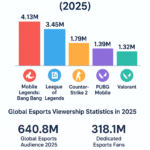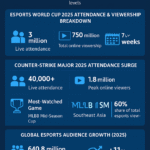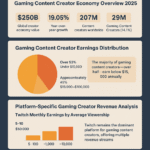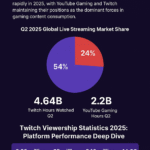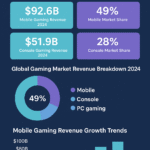College Esports Program Growth Statistics (2025)
In 2025, over 575 institutions across North America have embraced competitive gaming, offering structured programs that rival traditional sports in terms of organization, funding, and student engagement. This comprehensive analysis examines verified statistics on program expansion, scholarship distribution, market valuation, and career outcomes that define the current state of collegiate esports.
College Esports Program Expansion Across North American Institutions
The growth trajectory of collegiate esports programs demonstrates remarkable momentum, with a 44 percent increase since 2023. Regional universities lead this expansion with 220 programs, followed closely by major universities with 180 programs. Community colleges have shown the highest growth rate at 58 percent, reflecting the accessibility and low barrier to entry that makes esports an attractive option for diverse educational institutions.
| Institution Type | Number of Programs | Growth Since 2023 | Scholarship Availability |
|---|---|---|---|
| Major Universities | 180 | +35% | Yes |
| Regional Universities | 220 | +42% | Yes |
| Community Colleges | 100 | +58% | Limited |
| Private Institutions | 75 | +29% | Yes |
The total funding allocated to these programs exceeds 25 million dollars annually, supporting infrastructure development, coaching staff, and competitive travel expenses. This investment reflects institutional recognition of esports as a legitimate recruiting tool and student retention strategy.
Scholarship Opportunities and Funding in College Esports
Financial support for student gamers has reached unprecedented levels, with esports scholarships totaling 25 million dollars in 2025. Nearly 4,800 students benefit from these awards, which average approximately 5,208 dollars per recipient. This represents a strategic shift as universities leverage gaming scholarships to attract digitally native students and diversify their enrollment demographics.
Growth in Esports Scholarship Funding
The progression from 18 million dollars in 2023 to 25 million dollars in 2025 demonstrates sustained institutional commitment. These scholarships increasingly target underrepresented groups, including women gamers and first-generation college students, making varsity esports more accessible than traditional athletic programs. Universities report that esports scholarships yield higher application rates from tech-savvy students who might otherwise overlook their institutions.
| Year | Total Scholarship Funding | Number of Recipients | Average per Student |
|---|---|---|---|
| 2023 | $18 million | ~3,600 | $5,000 |
| 2024 | $22 million | ~4,200 | $5,238 |
| 2025 | $25 million | ~4,800 | $5,208 |
Market Size and Revenue Streams in Collegiate Esports
The United States collegiate esports market has reached a valuation of 1.1 billion dollars in 2025, with projections indicating a compound annual growth rate of 21.2 percent through 2029. This market encompasses sponsorship deals, media rights, operational infrastructure, and merchandise sales. Major brands including Coca-Cola, Nike, and Red Bull have invested heavily in collegiate gaming, recognizing the engaged audience and brand loyalty potential among young consumers.
Revenue Distribution in College Esports
Sponsorships constitute the dominant revenue stream, generating approximately 1.2 billion dollars annually across the broader esports ecosystem. Media rights contribute an additional 500 million dollars, with streaming platforms like Twitch and YouTube Gaming securing exclusive broadcast agreements for major collegiate tournaments. This financial ecosystem supports the infrastructure needed for professional-grade esports facilities on campus.
Academic Programs and Degree Pathways in Esports
Higher education institutions are integrating esports into formal curricula, with 85 universities now offering dedicated esports management degrees. These programs combine business administration, event management, digital marketing, and sports analytics to prepare students for industry careers. An additional 120 institutions provide game design and animation programs, while 60 colleges offer microcredentialing in specialized areas such as broadcasting and content creation.
Esports Management Degree Programs
The emergence of esports-specific academic pathways represents institutional validation of gaming as a viable career field. Students pursuing an esports management degree study tournament organization, team operations, sponsorship acquisition, and athlete development. These programs often include practicum experiences where students manage campus esports teams or coordinate competitive events, providing hands-on training that translates directly to industry employment opportunities.
| Academic Offering | Number of Institutions | Focus Areas |
|---|---|---|
| Esports Management Degrees | 85 | Management, Sports Analytics |
| Game Design Programs | 120 | Development, Animation, Modeling |
| Microcredentialing | 60 | Broadcasting, Streaming, Editing |
| Industry Internships | 150+ | Operations, Marketing, Production |
Viewership Trends and Student Engagement in College Esports
Audience engagement metrics reveal deepening viewer commitment to collegiate gaming content. The average session duration has increased to 41 minutes in 2025, representing a 6-minute gain since 2023. Mobile devices now account for 56 percent of live tournament viewership, reflecting consumption patterns among digitally native students who prefer flexible viewing options.
Digital Community Growth in College Gaming
Discord communities supporting college esports teams have expanded by 38 percent year-over-year, serving as hubs for team coordination, fan engagement, and social interaction. Campus watch parties have seen attendance increases of 45 percent, creating in-person social experiences around digital competition. These engagement patterns demonstrate how university esports teams foster community connections similar to traditional athletics while leveraging digital platforms for broader reach.
Most Popular Esports Titles in College Competition
League of Legends maintains its position as the dominant collegiate esports title with over 300 active college teams competing in organized leagues. Valorant follows with 250 teams, while Rocket League attracts 200 collegiate squads. Prize pools for these competitions have grown substantially, with League of Legends tournaments offering 1.5 million dollars in total prizes across various collegiate leagues in 2025.
Emerging Titles in Collegiate Competition
Marvel Rivals has emerged as a noteworthy addition to collegiate gaming, with 90 teams participating in its inaugural season within the Unified Collegiate League. This demonstrates how new game releases can quickly gain traction in the college esports ecosystem when supported by structured competitive frameworks and prize incentives. The diversity of game titles ensures that students with different gaming preferences can find competitive opportunities within their institutions.
| Game Title | Active College Teams | League Participation | 2025 Prize Pool |
|---|---|---|---|
| League of Legends | 300+ | UCL, MEC, MAEC | $1.5 million |
| Valorant | 250+ | UCL, MAEC | $1.2 million |
| Rocket League | 200+ | MEC, UCL | $900,000 |
| Overwatch 2 | 180+ | MAEC, UCL | $750,000 |
| Marvel Rivals | 90+ | UCL | $400,000 |
Diversity and Inclusion in College Esports Programs
Collegiate esports demonstrates stronger diversity metrics compared to traditional sports, with women comprising 32 percent of participants in 2025, a 9 percentage point increase since 2023. Students of color represent 38 percent of all collegiate esports participants, reflecting the inclusive nature of digital competition that removes many physical barriers associated with conventional athletics.
Expanding Access for Underrepresented Students
First-generation college students account for 18 percent of esports program participants, benefiting from digital-first scouting processes that identify talent regardless of geographic location or socioeconomic background. International students comprise 14 percent of collegiate gamers, with online tournament structures enabling global participation without requiring physical presence on campus. These accessibility factors position college esports as a pathway for diverse student populations to engage in competitive collegiate experiences.
| Demographic Group | Participation Rate 2025 | Change Since 2023 |
|---|---|---|
| Women in Esports | 32% | +9% |
| First-Generation Students | 18% | +6% |
| International Students | 14% | +4% |
| Students of Color | 38% | +11% |
Career Outcomes for Esports Program Graduates
Graduates from esports-integrated programs enter diverse career paths with competitive starting salaries. Game design and development positions offer average starting compensation of 62,000 dollars, with 28 percent of graduates pursuing this track. Esports event production roles provide 55,000 dollars on average, attracting 22 percent of program alumni who specialize in live operations, streaming infrastructure, and tournament logistics.
Employment Pathways for College Esports Graduates
Digital marketing and media careers attract 18 percent of graduates, with starting salaries around 50,000 dollars for roles in content creation and social media management. Broadcasting and journalism positions, including shoutcasting and esports reporting, offer 48,000 dollars to entry-level professionals. Team management and coaching roles, while comprising only 10 percent of career placements, provide essential leadership opportunities within collegiate and semi-professional esports organizations.
| Career Path | Average Starting Salary | % of Graduates |
|---|---|---|
| Game Design & Development | $62,000 | 28% |
| Esports Event Production | $55,000 | 22% |
| Digital Marketing & Media | $50,000 | 18% |
| Broadcasting & Journalism | $48,000 | 12% |
| Team Management & Coaching | $45,000 | 10% |
Future Growth Projections for College Esports
Forecasts for 2026 indicate continued expansion with over 650 college esports programs expected across North America. Scholarship funding is projected to reach 30 million dollars, driven by increased institutional support and corporate partnerships. Global collegiate viewership is anticipated to exceed 120 million across streaming platforms, reflecting the international appeal of competitive gaming at the university level.
Institutional Investment in Collegiate Gaming Infrastructure
Academic program offerings will expand to over 200 distinct esports-related degrees, microcredentials, and minors by 2026. This growth reflects university recognition that gaming skills translate to valuable competencies in technology, communication, and strategic thinking. Community colleges are expected to drive much of this expansion, making collegiate esports accessible to students pursuing associate degrees and vocational training pathways.
FAQs
How many college esports programs exist in 2025?
+There are 575 college esports programs operating across North America in 2025, representing a 44 percent increase from 2023. Regional universities lead with 220 programs, followed by major universities with 180 programs, community colleges with 100 programs, and private institutions with 75 programs.
What is the average esports scholarship amount in 2025?
+The average esports scholarship in 2025 is approximately 5,208 dollars per student. Total scholarship funding across all collegiate programs reaches 25 million dollars annually, supporting nearly 4,800 student gamers. Scholarship amounts vary by institution, with major universities typically offering larger awards than community colleges.
Which esports titles are most popular in college competition?
+League of Legends dominates collegiate esports with over 300 active teams, followed by Valorant with 250 teams and Rocket League with 200 teams. Other popular titles include Overwatch 2 with 180 teams and the emerging Marvel Rivals with 90 teams. These games offer structured collegiate leagues and substantial prize pools.
Can you get a degree in esports management?
+Yes, 85 institutions now offer dedicated esports management degrees in 2025. These programs cover tournament organization, team operations, sponsorship acquisition, sports analytics, and digital marketing. Additionally, 120 colleges provide game design programs, and 60 institutions offer microcredentialing in broadcasting and content creation related to esports.
What careers are available for college esports graduates?
+Esports graduates pursue careers in game design and development (average starting salary 62,000 dollars), event production (55,000 dollars), digital marketing (50,000 dollars), broadcasting and journalism (48,000 dollars), and team management (45,000 dollars). The field offers diverse opportunities across technology, entertainment, and media sectors.
How diverse are college esports programs?
+College esports programs show strong diversity metrics with women comprising 32 percent of participants and students of color representing 38 percent. First-generation college students account for 18 percent of participants, while international students make up 14 percent. These figures exceed diversity rates in many traditional collegiate sports.
What is the market size of collegiate esports?
+The United States collegiate esports market is valued at 1.1 billion dollars in 2025, with a projected compound annual growth rate of 21.2 percent through 2029. The global esports market, including professional and collegiate segments, reaches 3.25 billion dollars. Sponsorships and media rights constitute the primary revenue sources.
Do community colleges offer esports programs?
+Yes, 100 community colleges operate esports programs in 2025, showing the highest growth rate at 58 percent since 2023. While these programs typically offer limited scholarship availability compared to four-year institutions, they provide accessible entry points for students pursuing associate degrees and vocational training in gaming-related fields.
How long do viewers watch college esports content?
+The average session duration for college esports viewership reached 41 minutes in 2025, representing a 6-minute increase since 2023. Mobile devices account for 56 percent of live tournament viewing, while Discord communities supporting college teams have grown by 38 percent year-over-year, indicating strong audience engagement.
What are the projected growth trends for college esports?
+By 2026, over 650 college esports programs are expected across North America, with scholarship funding projected to reach 30 million dollars. Global collegiate viewership is anticipated to exceed 120 million viewers, while academic program offerings will expand to over 200 distinct esports-related degrees, microcredentials, and minors.
Sources
- Nameless Esports. “College Esports Program Statistics 2025.” https://www.namelessesports.com
- UNIFIED News. “Esports Scholarship Growth and Collegiate Gaming Trends.” https://www.unifiednews.com
- Sci-Tech Today. “Collegiate Esports Market Analysis 2025.” https://www.scitechtoday.com
- University of Cincinnati. “Academic Integration of Esports Programs.” https://www.uc.edu
- Aitechtonic. “Career Outcomes for Esports Graduates 2025.” https://www.aitechtonic.com

